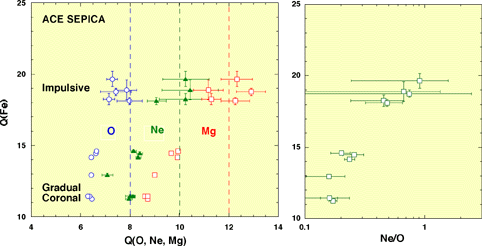


|
|
|
|
|

|
|
|
|
|
|
Charge State Variations between Impulsive and CME Related Solar Energetic Particle Events

Solar energetic particle (SEP) events are generally subdivided into two classes, impulsive events whose particles originate at the sun and gradual (or CME related) events with particle acceleration at the accompanying shock in the corona or in the solar wind. Impulsive SEP events are known to show a strong enrichment of ions heavier than oxygen (Z >= 10) relative to CNO compared with solar coronal abundances and CME related SEP events. These enrichments are usually interpreted in terms of physical processes that fractionate species based on their mass to charge ratio M/Q. Therefore, ionic charge state observations are crucial for the interpretation.
With ACE/SEPICA, charge states of a variety of elements can be determined for individual impulsive events for the first time. It is observed that the charge states of all elements increase from low values in gradual events to high values in impulsive events, as shown in the figure on the left. Furthermore, the enrichment of heavy ions correlates well with the observed ionic charge states of Fe in individual SEP events (shown for Ne in the figure on the right). The strongest enrichment of heavy ions is observed for events with the highest Fe charge states of ~20. However, in these very same events species such as O, Ne and Mg are essentially fully stripped, and thus M/Q~2 for the dominant isotopes (16O, 20Ne, 24Mg) of these species. As a result there is no difference in M/Q, for example, between Ne and O, which poses a serious challenge for models to explain the enrichment of heavy ions in these events.